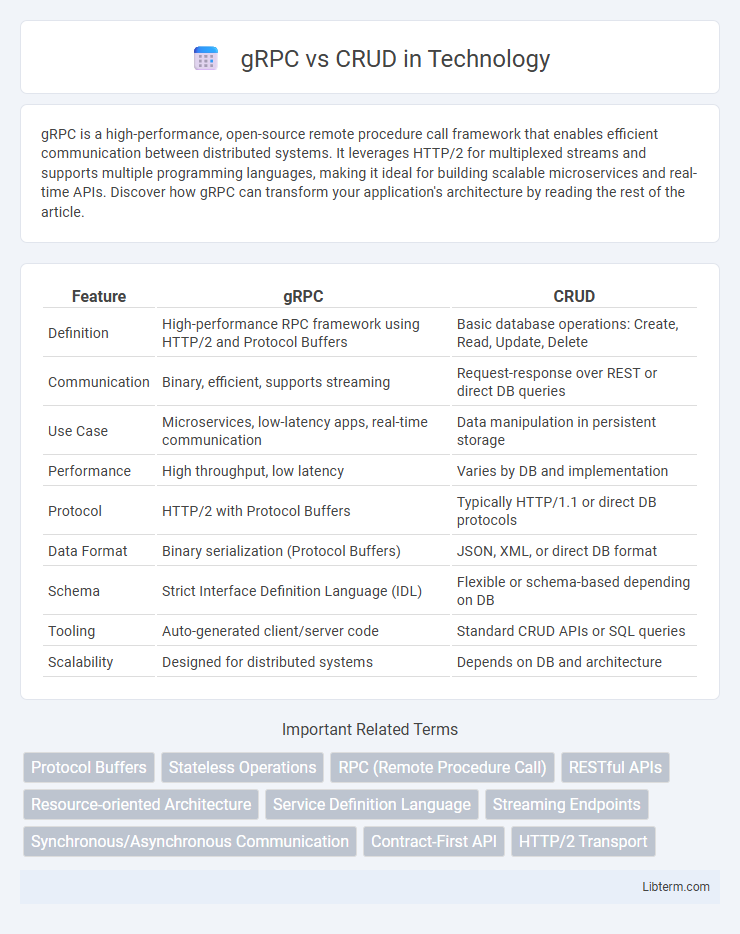gRPC is a high-performance, open-source remote procedure call framework that enables efficient communication between distributed systems. It leverages HTTP/2 for multiplexed streams and supports multiple programming languages, making it ideal for building scalable microservices and real-time APIs. Discover how gRPC can transform your application's architecture by reading the rest of the article.
Table of Comparison
| Feature | gRPC | CRUD |
|---|---|---|
| Definition | High-performance RPC framework using HTTP/2 and Protocol Buffers | Basic database operations: Create, Read, Update, Delete |
| Communication | Binary, efficient, supports streaming | Request-response over REST or direct DB queries |
| Use Case | Microservices, low-latency apps, real-time communication | Data manipulation in persistent storage |
| Performance | High throughput, low latency | Varies by DB and implementation |
| Protocol | HTTP/2 with Protocol Buffers | Typically HTTP/1.1 or direct DB protocols |
| Data Format | Binary serialization (Protocol Buffers) | JSON, XML, or direct DB format |
| Schema | Strict Interface Definition Language (IDL) | Flexible or schema-based depending on DB |
| Tooling | Auto-generated client/server code | Standard CRUD APIs or SQL queries |
| Scalability | Designed for distributed systems | Depends on DB and architecture |
Introduction to gRPC and CRUD
gRPC is a high-performance, open-source remote procedure call (RPC) framework developed by Google, designed for efficient communication between distributed systems using Protocol Buffers. CRUD (Create, Read, Update, Delete) represents the fundamental operations used in managing persistent data within databases and web services. While CRUD focuses on data manipulation at the application level, gRPC facilitates scalable, low-latency communication for invoking methods across different services.
Core Principles of gRPC
gRPC is built on the core principles of HTTP/2, enabling efficient binary serialization through Protocol Buffers, which provides faster communication and smaller message size compared to traditional CRUD operations based on REST and JSON. It supports bidirectional streaming, multiplexing, and built-in authentication, offering more scalable and real-time interaction models for distributed systems. Unlike CRUD's resource-centric approach, gRPC emphasizes service definition and contract-first API design, which ensures strong typing and automated code generation across multiple languages.
Fundamentals of CRUD Operations
CRUD operations form the foundation of data management, encompassing Create, Read, Update, and Delete actions essential for interacting with databases and persistent storage. gRPC, a high-performance RPC framework developed by Google, enhances CRUD operations by enabling efficient communication between client and server through protocol buffers and HTTP/2 transport. This integration improves scalability and performance for distributed systems that rely heavily on fundamental CRUD functionalities.
Communication Patterns: gRPC vs CRUD
gRPC employs a modern, contract-first communication pattern using HTTP/2 with support for multiplexed streaming, enabling efficient bi-directional communication and low-latency messaging. CRUD operations typically follow a request-response pattern over RESTful APIs using HTTP/1.1, which can introduce higher latency due to statelessness and separate requests for each operation. The streaming capabilities and binary protocol of gRPC offer a more performant alternative to the resource-based, stateless communication style inherent in CRUD.
Performance Comparison: gRPC and CRUD
gRPC offers significantly lower latency and higher throughput compared to traditional CRUD operations over REST due to its use of HTTP/2, binary serialization with Protocol Buffers, and multiplexed streams, which reduce network overhead and improve data transmission efficiency. CRUD-based REST APIs typically rely on JSON over HTTP/1.1, leading to higher serialization and parsing costs, resulting in increased response times and reduced performance under high load. Benchmark studies consistently demonstrate gRPC's superior performance in microservices and real-time applications, making it ideal for scenarios demanding fast, scalable communication.
Scalability Considerations
gRPC offers enhanced scalability through its support for multiplexed streams over a single HTTP/2 connection, reducing latency and resource consumption compared to traditional CRUD APIs that rely on separate HTTP requests for each operation. The binary serialization format of gRPC enables faster data interchange, improving performance in high-traffic environments. In contrast, CRUD operations using REST APIs may face bottlenecks due to stateless HTTP requests and verbose JSON payloads, which can hamper scalability in microservices architectures.
Use Cases: When to Choose gRPC
gRPC excels in high-performance, low-latency microservices communication, real-time data streaming, and environments where strong API contracts and efficient binary serialization are critical. It is ideal for complex distributed systems requiring scalability and inter-service communication with strict type safety, such as cloud-native applications and IoT platforms. gRPC is preferable over traditional CRUD APIs when synchronous responses and advanced features like multiplexing and bidirectional streaming improve overall system responsiveness and efficiency.
Use Cases: When CRUD is More Suitable
CRUD is more suitable for applications requiring simple, straightforward data manipulation tasks such as basic Create, Read, Update, and Delete operations commonly found in traditional database interactions and RESTful APIs. It excels in scenarios with well-defined data models and when clients primarily perform standard transactional work like form submissions, content management systems, or administrative dashboards. CRUD's stateless nature and widespread support across databases and web frameworks make it ideal for projects prioritizing simplicity and compatibility over complex real-time communication.
Security Implications of gRPC and CRUD
gRPC enhances security by supporting HTTP/2 with built-in TLS encryption, ensuring secure transport of data between client and server, while CRUD operations typically rely on REST APIs that may require additional configuration to achieve comparable security levels. The use of strong authentication and authorization mechanisms, such as OAuth2 or JWT, is critical in both gRPC and CRUD implementations to prevent unauthorized data access and manipulation. gRPC's binary protocol reduces the risk of injection attacks compared to traditional text-based CRUD APIs, improving overall security posture in modern distributed applications.
Final Thoughts: Choosing the Right Approach
gRPC offers high-performance, low-latency communication ideal for microservices and real-time applications, while CRUD APIs provide simplicity and ease of use for standard database operations. Selecting the right approach depends on project requirements, including scalability, network efficiency, and development complexity. Emphasizing system interoperability and expected workload patterns ensures optimal design and technology alignment.
gRPC Infographic

 libterm.com
libterm.com